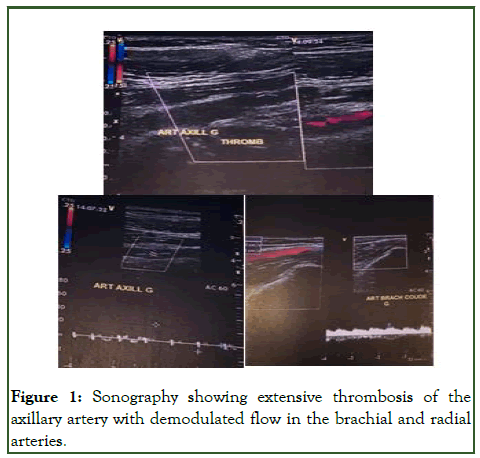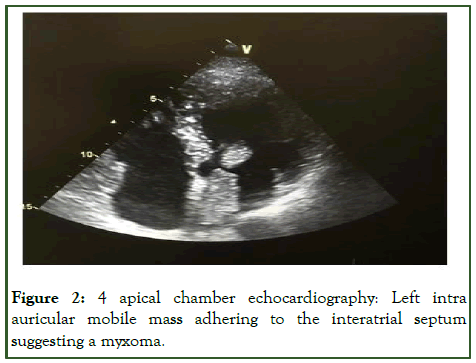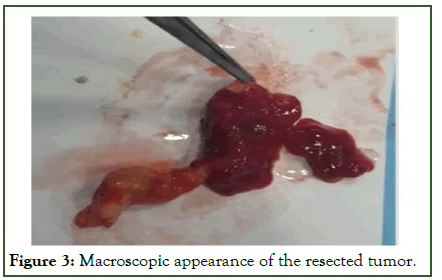Indexed In
- RefSeek
- Hamdard University
- EBSCO A-Z
- Publons
- Google Scholar
Useful Links
Share This Page
Journal Flyer

Open Access Journals
- Agri and Aquaculture
- Biochemistry
- Bioinformatics & Systems Biology
- Business & Management
- Chemistry
- Clinical Sciences
- Engineering
- Food & Nutrition
- General Science
- Genetics & Molecular Biology
- Immunology & Microbiology
- Medical Sciences
- Neuroscience & Psychology
- Nursing & Health Care
- Pharmaceutical Sciences
Case Report - (2024) Volume 10, Issue 3
Myxoma of the Left Atrium as an Uncommun Cause of Upper Limb Ischemia
Soukaina Scadi1,2*, Mohamed Yassine Benzha1,3, Bensahi Ilham1,2, Ncho Mottoh Marie-Paule1,2, Laarje Aziza1,2, El Ouarradi Amal1,2, Oualim Sara1,2, Abdeladim Salma1,2, El Harras Mahassine1,2, Benyoussef Hicham1,3, Makani Said1,3 and Sabry Mohamed1,22Department of Cardiology, International University Hospital Cheikh Khalifa, Casablanca, Morocco
3Department of Cardiac Surgery, International University Hospital Cheikh Khalifa, Casablanca, Morocco
Received: 25-Jan-2021, Manuscript No. JTCOA-24-8115; Editor assigned: 28-Jan-2021, Pre QC No. JTCOA-24-8115 (PQ); Reviewed: 11-Sep-2021, QC No. JTCOA-24-8115; Revised: 02-Sep-2024, Manuscript No. JTCOA-24-8115 (R); Published: 30-Sep-2024, DOI: 10.35248/2572-9462.24.10.281
Abstract
Acute upper limb ischemia is a rare condition often caused by thromboembolic events, with delayed diagnosis leading to significant impairment. We report an unusual case of acute upper extremity ischemia in a 48-year-old male due to embolization from a massive left atrial myxoma. The patient presented with left hemiparesis and absence of radial and ulnar pulses. Imaging confirmed axillary artery obstruction and echocardiography revealed a large left atrial myxoma. Surgical resection of the tumor and arterial thrombectomy were successfully performed. Early diagnosis and timely intervention are crucial in preventing complications from embolic myxomas.
Keywords
Left atrial myxoma; Embolisation; Acute arterial occlusion; Surgical resection
Introduction
Upper limb ischemia is an uncommon but serious condition characterized by insufficient blood flow to the arm, often resulting from arterial occlusion. While lower limb ischemia is more frequently encountered, upper limb ischemia is rare, especially when caused by cardiac embolism. Atrial myxoma, a benign heart tumor, is a rare but important cause of embolic events, typically affecting the central nervous system or lower extremities [1]. However, in extremely rare cases, myxomas can lead to upper limb ischemia. This report highlights a unique case of acute upper extremity ischemia resulting from embolization due to a left atrial myxoma, emphasizing the importance of early detection and intervention to prevent irreversible damage [2].
Cardiac myxomas are the most common benign tumors of the heart, with the majority occurring in the left atrium. These tumors arise from subendocardial mesenchymal cells and are most frequently diagnosed in individuals between the third and sixth decades of life. While some patients with myxomas may remain asymptomatic, others present with a wide range of symptoms, including shortness of breath, syncope, palpitations and heart failure. In some cases, the first sign of a myxoma may be a serious complication, such as a stroke or peripheral ischemia caused by embolization [3].
Although embolic events due to atrial myxomas often affect the central nervous system, peripheral embolization is a rare but dangerous occurrence, particularly when it leads to acute ischemia in areas such as the upper limbs. Early recognition of this uncommon cause is critical for preventing severe complications and ensuring effective treatment [4].
In this article, we present a rare case of acute upper limb ischemia caused by a large left atrial myxoma in a 48-year-old man. This case highlights the importance of considering cardiac sources of emboli in patients with acute arterial ischemia, particularly in the absence of traditional cardiovascular risk factors [5].
Cardiac myxoma is a benign tumor of the heart, most often in the left atrium. Myxoma originates from the subendocardial mesenchymal cells. Occurring mainly in the 3rd-6th decades of life. 85% are located in the left atrium, with 15% in the right atrium. Cardiac symptoms differ from one subject to another:
Shortness of breath, discomfort, syncope, pallor, palpitations, heart failure. It can be completely asymptomatic. It can also be revealed by a complication such as a stroke or an acute ischemia of another localization, secondary to an embolization. We report an unusual case of a of acute upper limb ischemia due to a massive atrial myxoma in a 48-year-old man [6].
Case Presentation
A 48 years old man, with low cardio-vascular risk profile and no history, who presented with hemiparesis of the left upper limb, no palpable left radial or ulnar artery and normal neurological and CT examination, with confirmed acute ischemia related to left axillary obstruction at echodoppler with demodulated flow in the brachial and radial arteries and CT-angiography (Figure 1). As part of the etiological assessment, ECG and 24 h ECG were normal, we performed an echocardiogram, it suggested left atrium myxoma (Figure 2) [7].

Figure 1: Sonography showing extensive thrombosis of the axillary artery with demodulated flow in the brachial and radial arteries.

Figure 2: 4 apical chamber echocardiography: Left intra auricular mobile mass adhering to the interatrial septum suggesting a myxoma.
Anticoagulant and antithrombotic therapy were administered. A timely open heart surgery was performed, extraction of the left intra auricular mass and fogartisation of the axillary artery with removal of the myxoid material (Figure 3). The microscopic findings of the resected tumor and embolism specimens were myxoma [8].

Figure 3: Macroscopic appearance of the resected tumor.
After surgery, the patient was discharged from hospital without complications.
Results and Discussion
Atrial myxoma accounts for approximately 50% of all cardiac tumors, followed by lipoma and papillary fibroelastoma. The majority of myxomas are located in the left atrium. The prevalence of embolism due to cardiac myxoma is reported as 33%, which is not a rare complication of this disease. However, the prevalence of peripheral embolism due to left atrial myxoma is extremely rare (0.9%). Myxomas can present at any age group but occurs more often between the 3rd and 6th decades of life [9].
Patients with myxomas usually have non-specific symptoms, since the ability to embolize it can cause fatal complications. Most of these tumors embolize the central nervous system, resulting in cerebrovascular accidents; secondary embolization of coronary arteries, kidneys, intestines and peripheral arteries also occur. Echocardiography considered as the first-line imaging modality, cardiac CT has become an increasingly utilized tool for the evaluation of cardiac masses, which offers high isotropic spatial and temporal resolution, fast acquisition times and multiplanar image reconstruction capabilities [10].
Cardiac MRI (CMR) could also strengthen the diagnostic accuracy by providing superior soft tissue contrast which distinctly detects the internal details of myxomas, such as rupture and hemorrhage. The patient in our case immediately performed TTE when transferred to our hospital, combined with symptoms, the diagnosis is clear. In patients with atrial myxoma, TTE or TEE is still the most important means to diagnosis.
Coronary Angiography (CA) may also be useful in the further differentiation between cardiac tumors and thrombi. Parwis et al. suggested that CA should only be performed in patients over 40 years old, particularly those with atherosclerotic risk factors who require surgical removal of a cardiac mass.
Although rare, cardiac myxoma may recur after surgical resection and is estimated to be less than 3% in solitary tumors and 12% to 22%in familial forms. Therefore, echocardiographic follow-up within 1 year is very important.
In the present case, acute, upper limb ischemia was due to the huge left atrial tumor, which was confirmed by microscopic findings. An embolic myxoma should be included in the differential diagnosis in young and otherwise healthy patients who present with acute arterial ischemia, as in the present case.
Conclusion
We reported a rare case of acute, upper limb ischemia in a 48- year-old man due to an embolic episode of a huge left atrial myxoma, which we treated by open heart surgery and fogartisation. For patients with atrial myxoma, early diagnosis of is essential to allow proper treatment on time. Anticoagulant or antithrombotic therapy and surgery have a great importance to prevent and avoid potentially harmful complications such us embolism.
References
- Nina VJ, Silva NA, Gaspar SF, Raposo TL, Ferreira EC, Nina RV, et al. Atypical size and location of a right atrial myxoma: A case report. J Med Case Rep. 2012;6:1-5.
[Crossref] [Google Scholar] [PubMed]
- Dag O, Kaygın MA, Erkut B. Analysis of risk factors for amputation in 822 cases with acute arterial emboli. Scientific World Journal. 2012;2012(1):673483.
[Crossref] [Google Scholar] [PubMed]
- Diaz A, di Salvo C, Lawrence D, Hayward M. Left atrial and right ventricular myxoma: An uncommon presentation of a rare tumour. Interact Cardiovasc Thorac Surg. 2011;12(4):622-625.
[Crossref] [Google Scholar] [PubMed]
- Liesting C, Ramjankhan FZ, van Herwerden LA, Kofflard MJ. Systemic embolisation as presentation and recurrence of cardiac myxoma two years after surgery. Neth Heart J. 2010;18:499-502.
[Crossref] [Google Scholar] [PubMed]
- Kassop D, Donovan MS, Cheezum MK, Nguyen BT, Gambill NB, Blankstein R, et al. Cardiac masses on cardiac CT: A review. Curr Cardiovasc Imaging Rep. 2014;7:1-3.
[Crossref] [Google Scholar] [PubMed]
- Coley C. Complete embolization of a left atrial myxoma resulting in acute lower extremity ischemia. Tex Heart Inst J. 2005;32:238-240.
[Google Scholar] [PubMed]
- Panos A, Kalangos A, Sztajzel J. Left atrial myxoma presenting with myocardial infarction: Case report and review of the literature. Int J Cardiol. 1997; 62(1):73-75.
[Crossref] [Google Scholar] [PubMed]
- Vogel B, Thomas D, Mereles D, Rottbauer W, Katus HA. Systemic embolization and myocardial infarction due to clinically unrecognized left atrial myxoma. Case Rep Med. 2011;2011:1-3.
[Crossref] [Google Scholar] [PubMed]
- Attar MN, Moore RK, Khan S. Left atrial myxoma presenting with ventricular fibrillation. J Cardiovasc Med (Hagerstown). 2008;9(3):282-284.
[Crossref] [Google Scholar] [PubMed]
- Shavit L, Appelbaum L, Grenader T. Atrial myxoma presenting with total occlusion of the abdominal aorta and multiple peripheral embolism. Eur J Intern Med. 2007;18(1):74-75.
[Crossref] [Google Scholar] [PubMed]
Citation: Scadi S, Benzha MY, Ilham B, Marie-Paule NM, Aziza L, El Ouarradi A, et al. (2024) Myxoma of the Left Atrium as an Uncommun Cause of Upper Limb Ischemia. J Thrombo Cir. 10:281.
Copyright: © 2024 Scadi S, et al. This is an open-access article distributed under the terms of the Creative Commons Attribution License, which permits unrestricted use, distribution, and reproduction in any medium, provided the original author and source are credited.
